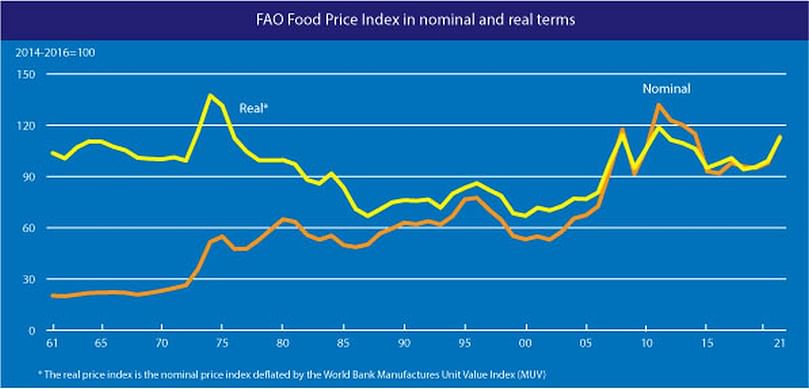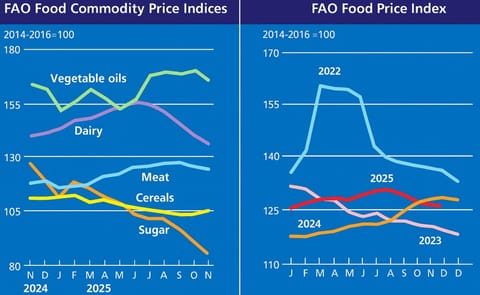Another surge in the value of FAO Food Price Index in January
Another surge in the value of FAO Food Price Index in January

The FAO Food Price Index (FFPI) averaged 113.3 points in January 2021, 4.7 points (4.3 percent) higher than in December 2020, not only marking the eighth month of consecutive rise but also registering its highest monthly average since July 2014. The latest increase reflected strong gains in the sugar, cereals, and vegetable oils sub-indices, while meat and dairy values were also up but to a lesser extent.
The FAO Cereal Price Index averaged 124.2 points in January, marking a sharp increase of 8.3 points (7.1 percent) from December and the seventh consecutive monthly rise. International maize prices increased significantly, surging by 11.2 percent in January, up 42.3 percent above their January 2020 level, reflecting increasingly tight global supply with lower-than-earlier-expected production and stock estimates in the United States of America and substantial purchases by China.
Concerns over dryness in South America and a temporary suspension of maize export registrations in Argentina added support, pushing international maize prices up to their highest level since mid-2013. Among other coarse grains, barley prices also increased in January, by 6.9 percent, supported by firmer demand and price rises for maize, wheat, and soybeans, while sorghum prices remained stable.
Wheat prices also registered strong increases in January, up by 6.8 percent, influenced by the strength in maize prices as well as strong global demand and expectations of reduced sales by the Russian Federation from March 2021, when the wheat export duty will double. As for rice, robust demand from Asian and African buyers, combined with tight supplies in Thailand and Viet Nam, continued to underpin export prices in January.
The FAO Vegetable Oil Price Index averaged 138.8 points in January, up 7.7 points (or 5.8 percent) from December and marking the highest level since May 2012. The index’ eighth consecutive monthly increase mainly reflected higher palm, soy and sunflowerseed oil prices. With palm oil production in both Indonesia and Malaysia turning out lower than earlier expected due to excessive rainfall (and, in the case of Malaysia, continued shortages in migrant labour force), international palm oil quotations climbed to eight-and-a-half year highs.
Meanwhile, international soyoil prices rose for the eighth month in succession, fuelled by reduced export availabilities and prolonged strikes in Argentina. As for sunflowerseed oil, continued rising prices stemmed from lingering global supply tightness owing to sharply reduced 2020/21 sunflowerseed harvests.
The FAO Dairy Price Index averaged 111.0 points in January, up 1.7 points (1.6 percent) from December 2020, rising for the eighth consecutive month and placing the index at 7.1 points (6.9 percent) above its value in the corresponding month last year. In January, butter and whole milk powder (WMP) price quotations increased, underpinned by China's high purchases in the wake of the country’s upcoming New Year holiday festivities amid seasonally lower exportable supplies in New Zealand.
Price quotations for skim milk powder (SMP) too rose, pressured by high import demand for spot supplies and lagging production activities in Western Europe. By contrast, cheese prices fell slightly from the highs registered in December 2020 due to limited internal sales in Europe, coupled with a stock build-up in the United States of America.
The FAO Meat Price Index* averaged 96.0 points in January, up 0.9 points (1.0 percent) from December 2020, marking the fourth consecutive monthly increase, but still down 7.6 points (7.3 percent) from the corresponding month last year.
International price quotations for all meat types that constitute the index increased in January, with those of poultry meat rising the most, especially for Brazilian origins, underpinned by brisk global import demand while avian influenza outbreaks constrained poultry exports from several European countries.
Despite high purchases by China in the run-up to the country’s New Year celebrations, bovine and pig meat price quotations increased only slightly, as global supplies remained adequate to meet demand. Ovine meat prices firmed for a fourth consecutive month, driven by tight supplies from Oceania and strong demand from China.
The FAO Sugar price index averaged 94.2 points in January, up 7 points (8.1 percent) from December 2020 and reaching the highest level since May 2017. The increase in prices mostly resulted from concerns over lower global availabilities in 2020/21, following worsening crop prospects in the European Union, the Russian Federation, and Thailand, and drier-than-normal weather conditions in South America.
Further support to sugar prices was provided by recent increases in crude oil prices and the strengthening of the Brazilian Real against the US Dollar, which tends to affect shipments from Brazil, the world's largest sugar exporter.
Continued robust global import demand for sugar also supported prices. The upward pressure on prices was somewhat limited by the large exportable supplies in India amid expectations of a bumper crop and the Government’s approval of export subsidies for the 2020/21 season.









